Growing Grapes in a Greenhouse: From Sunny Vines to Amber Clusters

Do you dream of your own juicy, sweet grapes, but the harsh climate of your region or limited space in your garden seem like an insurmountable obstacle? Perhaps you've already experienced disappointment when the vagaries of the weather ruined your long-awaited outdoor harvest, or perhaps you simply want to extend the season of enjoying this sunny berry? If the thought of amber or deep blue grapes ripening under your protection fills you with enthusiasm, then... the greenhouse can become The key to the viticulture of your dreams! This isn't just a shelter, but a whole world of possibilities for producing a consistent, high-quality harvest, even from the most heat-loving varieties. Let's uncover all the secrets of greenhouse viticulture together and turn your dream into reality!
Benefits of growing grapes in a greenhouse
Growing grapes in protected soil conditions offers winegrowers, especially in regions with moderate and cool climates, a number of significant advantages:
- Accelerated ripening and earlier harvest: In a greenhouse, the sum of active temperatures is higher, which allows the grapes to ripen 2-4 weeks, and sometimes even a month earlier, than in open ground.
- Extending the growing season: A greenhouse allows vines to begin growing earlier in the spring and go dormant later in the fall, which promotes better shoot ripening and the establishment of a harvest for the following year.
- Protection from adverse weather conditions: Grapes in a greenhouse are protected from spring and autumn frosts, hail, strong winds, and prolonged rains, which can damage the vines, inflorescences, and berries, as well as contribute to the development of diseases.
- Possibility of growing heat-loving and valuable varieties: In a greenhouse, grape varieties with a long growing season and high heat requirements can be successfully cultivated, which do not ripen in open ground in a given region.
- Improved crop quality: Greenhouse-grown berries often grow larger, sweeter (due to increased sugar accumulation), with better flavor and presentation. The risk of berry cracking due to excess moisture is reduced.
- Reducing the risk of fungal diseases: With proper agricultural practices and good ventilation in the greenhouse, you can create less favorable conditions for the development of common grape diseases such as mildew and oidium.
- Protection from birds and wasps: Greenhouse crops are easier to protect from birds and sweet-toothed insects.
- Crop Stability: Greenhouse conditions smooth out the effects of weather fluctuations, providing a more predictable and consistent crop from year to year.
Choosing a grape variety for a greenhouse
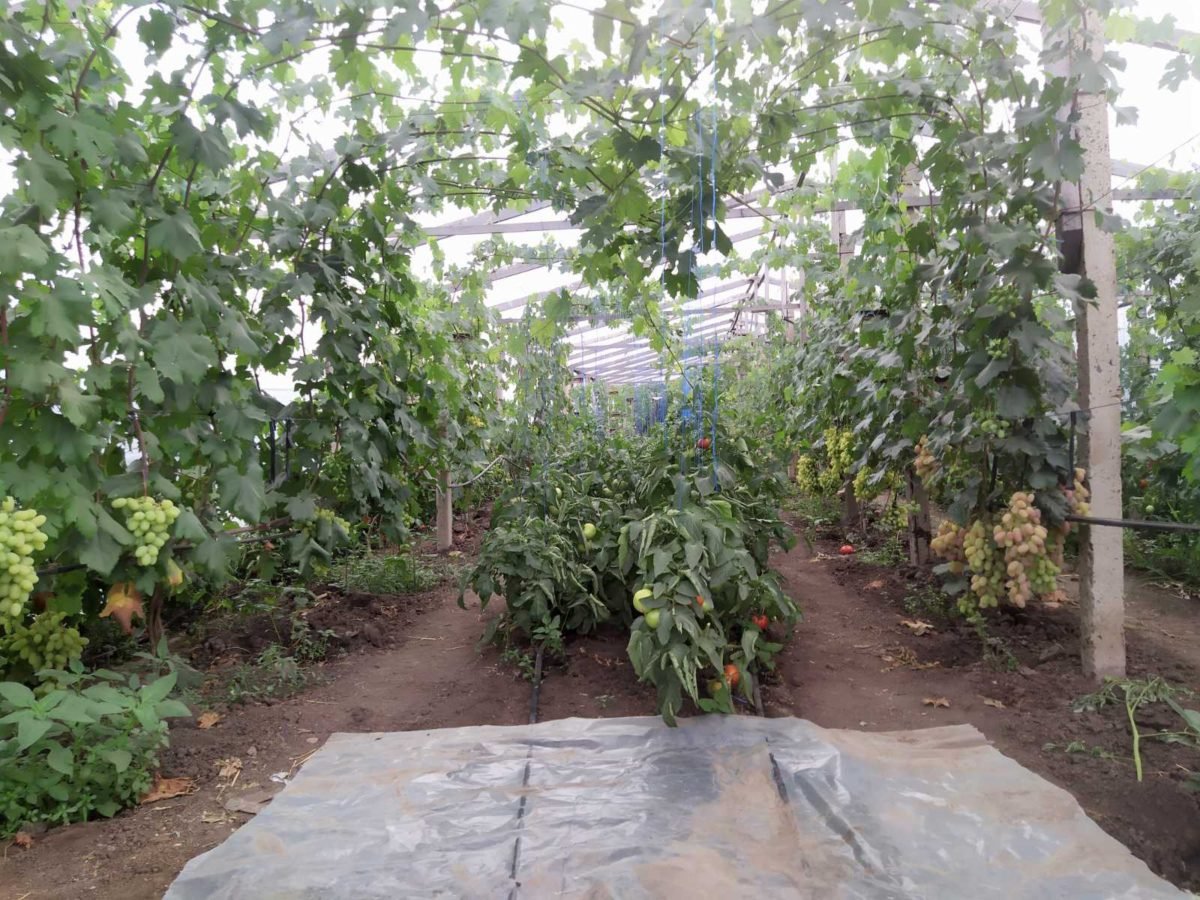
Choosing the right variety is the key to success in greenhouse viticulture. Preference should be given to varieties that:
- Early or very early ripening: This will allow you to get a harvest even in short summer conditions or with minimal heating of the greenhouse.
- Resistant to major grape diseases: Although the risk is lower in a greenhouse, the resistance of a variety is always a plus.
- The berries have good taste and marketable appearance.
- They have moderate to high yields.
- They respond well to conditions of high humidity and temperature (although this can be regulated).
Recommended groups and varieties of grapes for greenhouses:
- Extra early and very early varieties:
- 'Vostorg': Very early, high-yielding, and disease-resistant. The berries are white, large, and sweet.
- 'Arcadia': Early, very productive. Large clusters, white, oval berries with a pleasant muscat aroma. Requires good care.
- 'Kodryanka': Very early, dark blue. Large, elongated berries. Disease-resistant.
- 'Rusbol' (Elf): Very early, seedless (sultana). The berries are white, oval, and sweet. Disease and frost resistant.
- 'Harold': Very early, white, with a muscat aroma. Resistant.
- 'Super Extra': Very early, berries are large, white, crispy.
- Early varieties:
- 'Laura' (Flora): Early, high-quality. The berries are large, oval, milky-white, with firm flesh.
- 'Kishmish Luchisty': Early, pink, seedless. Elongated berries with a muscat aroma. Requires high care.
- 'Victoria': Early, pink-red. Large berries with a muscat flavor. Disease-resistant.
- 'Aleshenkin': Early, amber-white. Large clusters. Prone to overproduction.
- Varieties that have proven themselves well in protected ground:
- 'Muscat Hamburg': A classic Muscat variety, dark blue. Produces excellent results in greenhouses.
- 'Cardinal': Large-fruited, red-purple. Requires warmth.
- Some European varieties (Vitis vinifera): In heated greenhouses, you can try growing later, valuable European varieties that are unthinkable for open ground in cool regions.
What to look for when choosing:
- Bush growth force: For small greenhouses, it is better to choose varieties with moderate growth force.
- Pollination: Most modern varieties have bisexual flowers and self-pollinate well. However, in greenhouse conditions, artificial pollination may sometimes be necessary.
- Purpose: Table varieties for fresh consumption, raisins (seedless) or universal.
Where to buy seedlings?
Buy seedlings from reputable nurseries or reputable grape growers. They should be healthy, with a well-developed root system and mature stems.
Preparing the greenhouse and soil
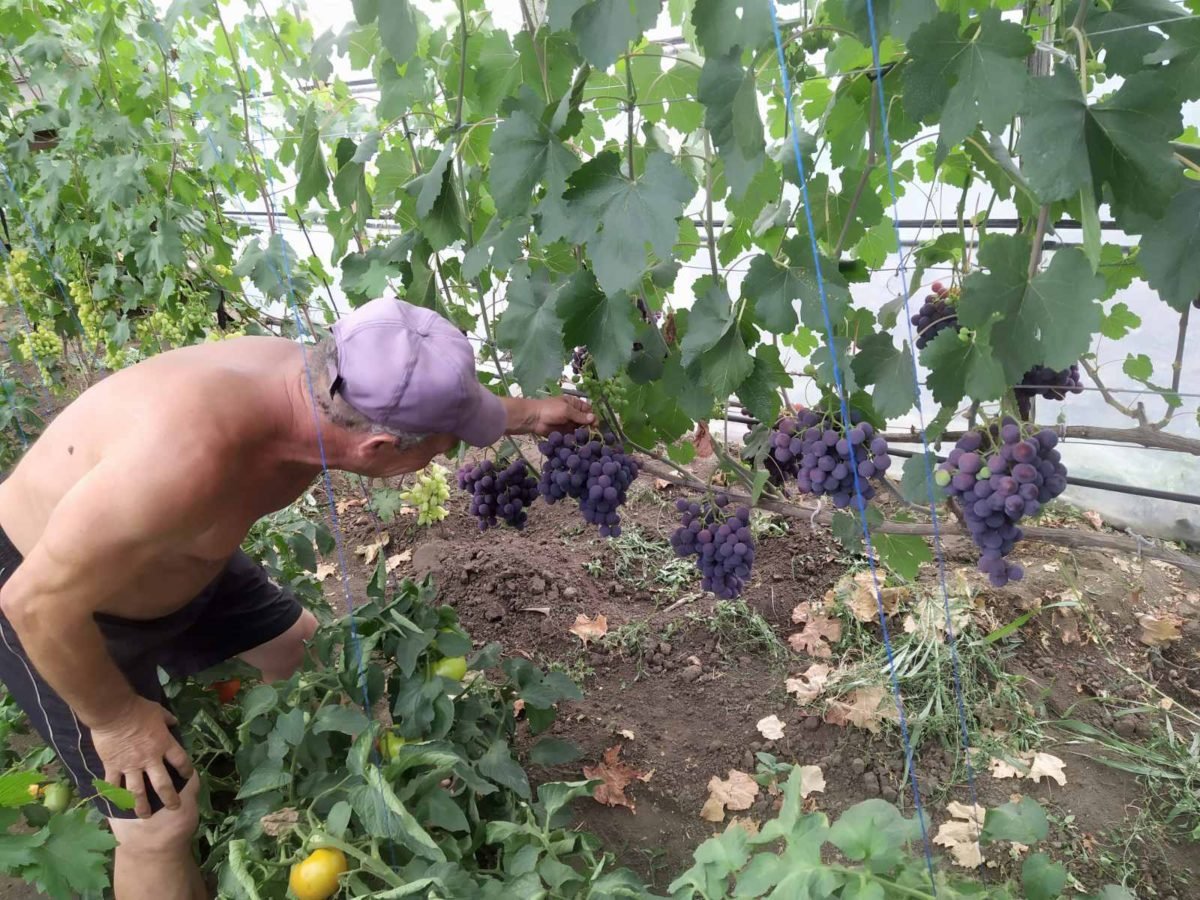
Careful preparation of the greenhouse and soil is the basis for future success.
Greenhouse requirements:
- Size and height: Grapes are vigorous vines, so the greenhouse must be spacious and high enough (preferably at least 2.5-3 m at the ridge) to provide space for the bush to form.
- Structural strength: The frame must be able to withstand the weight of the vines with the harvest and possible snow loads.
- Coating material: Polycarbonate (retains heat well, diffuses light, is durable) or glass (excellent light transmission, but fragile and heavy).
- Ventilation: Critically important! Provide sufficient vents (top and side) to ensure effective ventilation and prevent overheating and stagnant humid air. Installing automatic ventilation systems is recommended.
- Heating (if possible): For extra-early harvests or for growing heat-loving varieties in cold climates, a heating system may be necessary (at least to protect against spring frosts).
- Light: Grapes love light. Place the greenhouse in a well-lit area.
Soil requirements:
Grapes prefer loose, fertile, well-drained soils.
- Soil type: Light loam or sandy loam, rich in organic matter, are optimal. Heavy clay soils require improvement.
- Acidity (pH): 6.0-7.0 (neutral or slightly acidic).
- Drainage: Standing water is detrimental to grapes. If there is a risk of flooding, ensure good drainage or plant on raised beds.
Stages of soil preparation in a greenhouse:
- Planning the placement: Think about the planting pattern and the location of the trellises in advance.
- Digging planting holes (or trenches): This is done in the fall or 1-2 months before spring planting.
- Pit size: at least 60x60x60 cm, preferably 80x80x80 cm. For trench planting – depth and width 60-80 cm.
- Creating a drainage layer: Place a drainage layer (15-20 cm) of broken brick, crushed stone, or expanded clay at the bottom of the pit.
- Filling the hole with nutrient mixture:
- Mix the top fertile layer of soil with rotted manure or compost (1-2 buckets per hole), superphosphate (150-200 g), potassium salt or wood ash (0.5-1 l).
- Fill the hole with this mixture, leaving 10-15 cm from the top.
- Water thoroughly to settle the soil.
Planting grapes in a greenhouse
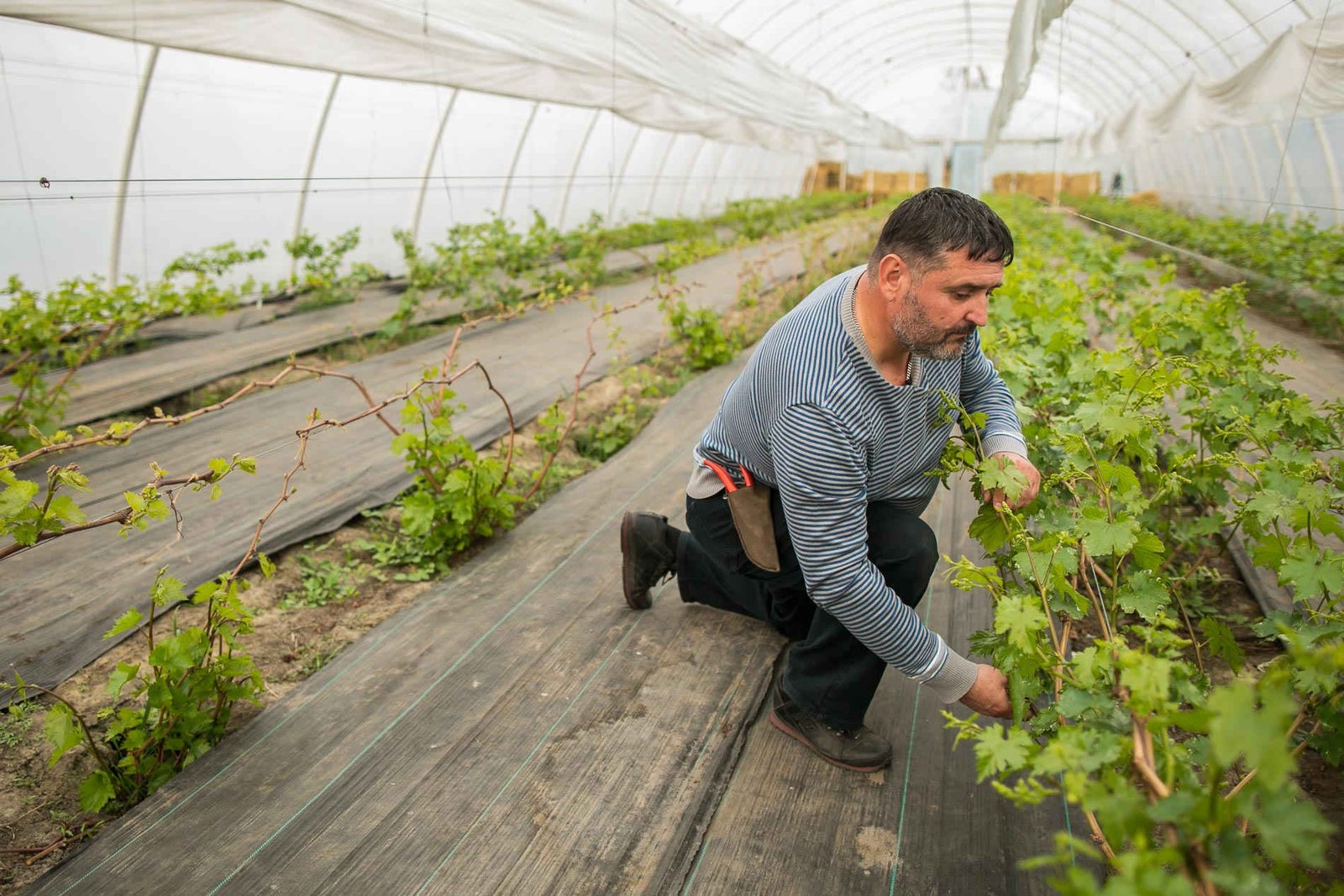
Planting times:
- Spring: The optimal time is April-May, when the soil in the greenhouse has warmed up sufficiently (up to +10-12°C at the planting depth) and the threat of severe frost has passed (if the greenhouse is unheated).
- Autumn: Planting is possible in September-October (3-4 weeks before the soil freezes), but in greenhouse conditions, spring planting is often preferable, as it gives the seedling more time to take root and adapt.
Preparing seedlings for planting:
- One-year-old seedlings: Before planting, the roots are refreshed (cut by 1-2 cm), soaked in water for 12-24 hours (it is possible to add a root formation stimulator, for example, “Kornevin”).
- Green (vegetative) seedlings: Planted by transshipment, trying not to destroy the root ball.
Planting technique:
- In the center of the prepared planting hole, make a mound of fertile soil.
- Place the seedling on the mound, carefully spreading the roots along its slopes. The heel (base) of the seedling should be 30-50 cm below the soil surface (depending on the region and soil type; deeper in colder conditions).
- Cover the roots with fertile soil, gradually compacting it with your hands to eliminate air pockets. The top buds on the shoot should be at or slightly above the soil level.
- Water the seedling generously (2-3 buckets of water).
- After the water has been absorbed, mulch the soil around the seedling with peat, humus or agrofibre.
- Install temporary support for the young shoot.
Planting scheme:
- Distance between bushes in a row: 1.5-2.5 m (depending on the growth strength of the variety and formation).
- Distance between rows (if there are several): 2-2.5 m.
- Often in greenhouses, grapes are planted along the walls, leaving the center for other crops or a walkway.
Caring for grapes in a greenhouse
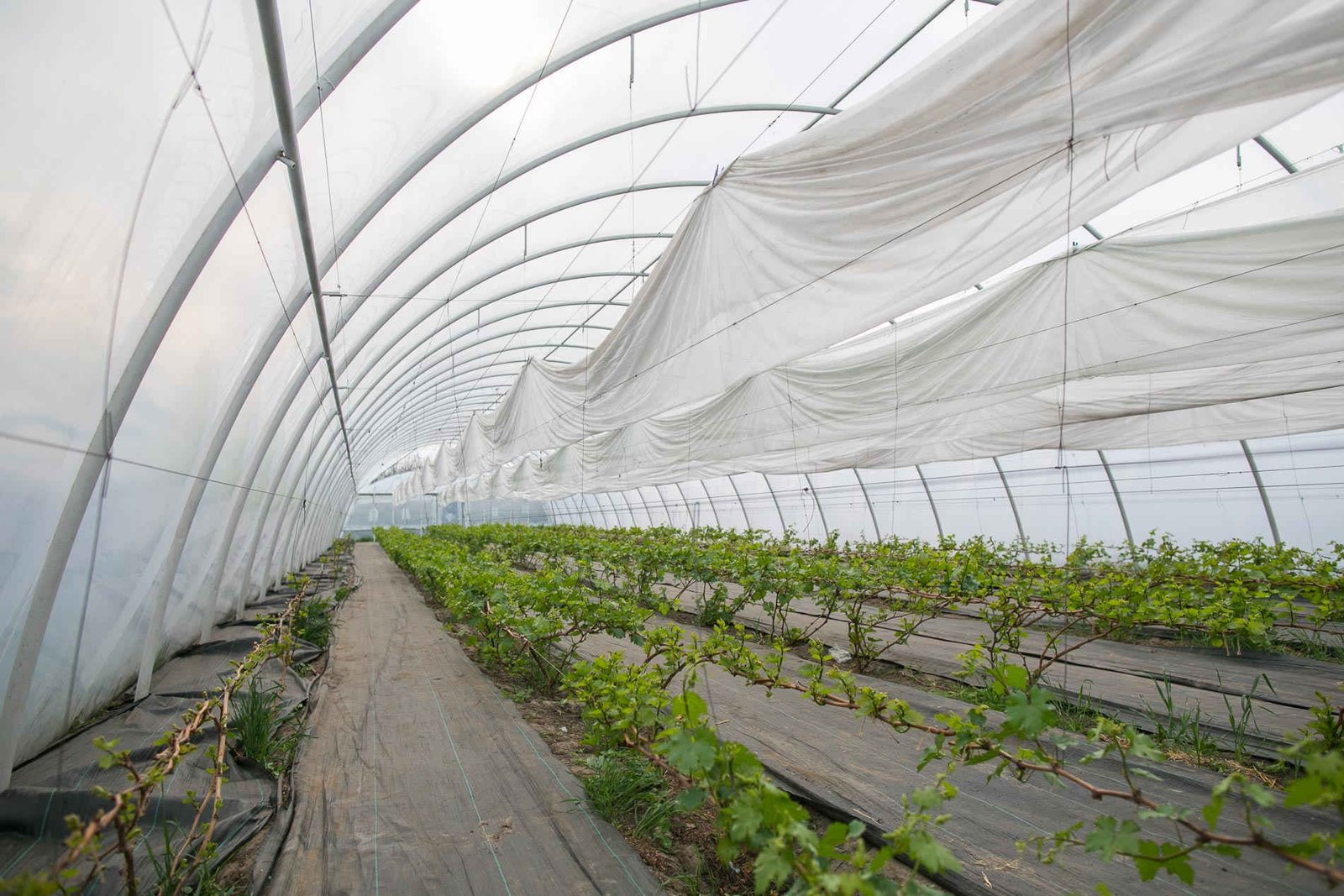
- Watering:
- Grapes need regular watering, especially during the period of active growth, flowering and berry filling.
- Frequency: Dependent on weather, development stage, and soil type. On average, once every 7-10 days.
- Norm: Water generously to wet the root zone (to a depth of 50-70 cm).
- Methods: Watering in holes, in furrows, drip irrigation (preferred).
- Important:
- Stop watering 2-3 weeks before harvesting to allow the berries to absorb more sugar and prevent cracking.
- Avoid overwatering, especially in combination with low temperatures, which can lead to the development of fungal diseases.
- After watering, it is recommended to loosen the soil or mulch.
- Top dressing:
- Grapes respond well to fertilizing.
- Spring (beginning of the growing season): Nitrogen fertilizers to stimulate growth (e.g. ammonium nitrate, urea).
- Before flowering: Complex mineral fertilizer with a predominance of phosphorus and potassium.
- After flowering (during berry growth): Phosphorus-potassium fertilizers. You can use wood ash infusion.
- After harvesting (for vine ripening and preparation for winter): Phosphorus-potassium fertilizers.
- Responds well to foliar feeding with microelements (boron, zinc, magnesium), especially before flowering and during the period of berry filling.
- Organic fertilizers (rotted manure, compost) are added once every 2-3 years in the fall during digging.
- Shaping and pruning:
This is one of the most important and difficult aspects of grape care, especially in a greenhouse where space is limited.
- The goals of pruning: To create a certain shape of the bush, regulate the load of the crop, provide good lighting and ventilation, and facilitate maintenance.
- Types of greenhouse formations:
- Fan-shaped: Suitable for planting against walls.
- Cordon (horizontal or inclined): Allows for even distribution of fruit links.
- Various modifications of trellis formations.
- Basic operations:
- Pruning for fruiting (in autumn or early spring before the sap begins to flow): Removing vines that have borne fruit, forming fruiting links (replacement knot and fruiting arrow).
- Green Operations (during summer):
- Breaking off excess shoots: Removing doubles, triplets, weak and sterile shoots.
- Pinching out side shoots: Removing or pinching out side shoots (lateral shoots growing from the leaf axils).
- Pinching: Removing the tops of shoots (at the end of summer) to stop their growth and improve ripening of the vines and berries.
- Thinning of leaves: In the cluster area to improve lighting and ventilation (but not excessively, so as not to cause sunburn of the berries).
- Crop rationing: Removing excess inflorescences or clusters so as not to overload the bush.
- Garter: As the shoots grow, they are tied to the trellis, directing them in the desired direction.
- Pollination:
- Most modern grape varieties are self-pollinating. However, in the closed conditions of a greenhouse, where there is no wind and few insects, pollination may be incomplete.
- To improve pollination:
- Light tapping on the trellis during flowering.
- Using a fan to create air movement.
- Artificial pollination with a powder puff (transfer of pollen from one flower to another).
- Temperature conditions and ventilation:
- Optimum temperature for growth and development: +22-30°C during the day, +16-20°C at night.
- Ventilation: Regular and thorough ventilation of the greenhouse is essential! This helps prevent overheating (temperatures above 35-40°C are detrimental to grapes), reduce humidity, and prevent the development of fungal diseases. Open windows and doors, especially on hot days.
- Maintaining air humidity:
- Optimal humidity is 60-70°C. Air that is too dry can cause wilting, while air that is too humid can lead to disease.
- In hot weather, you can lightly spray the paths with water to increase humidity (but not the plants themselves before sunset).
Disease and pest control
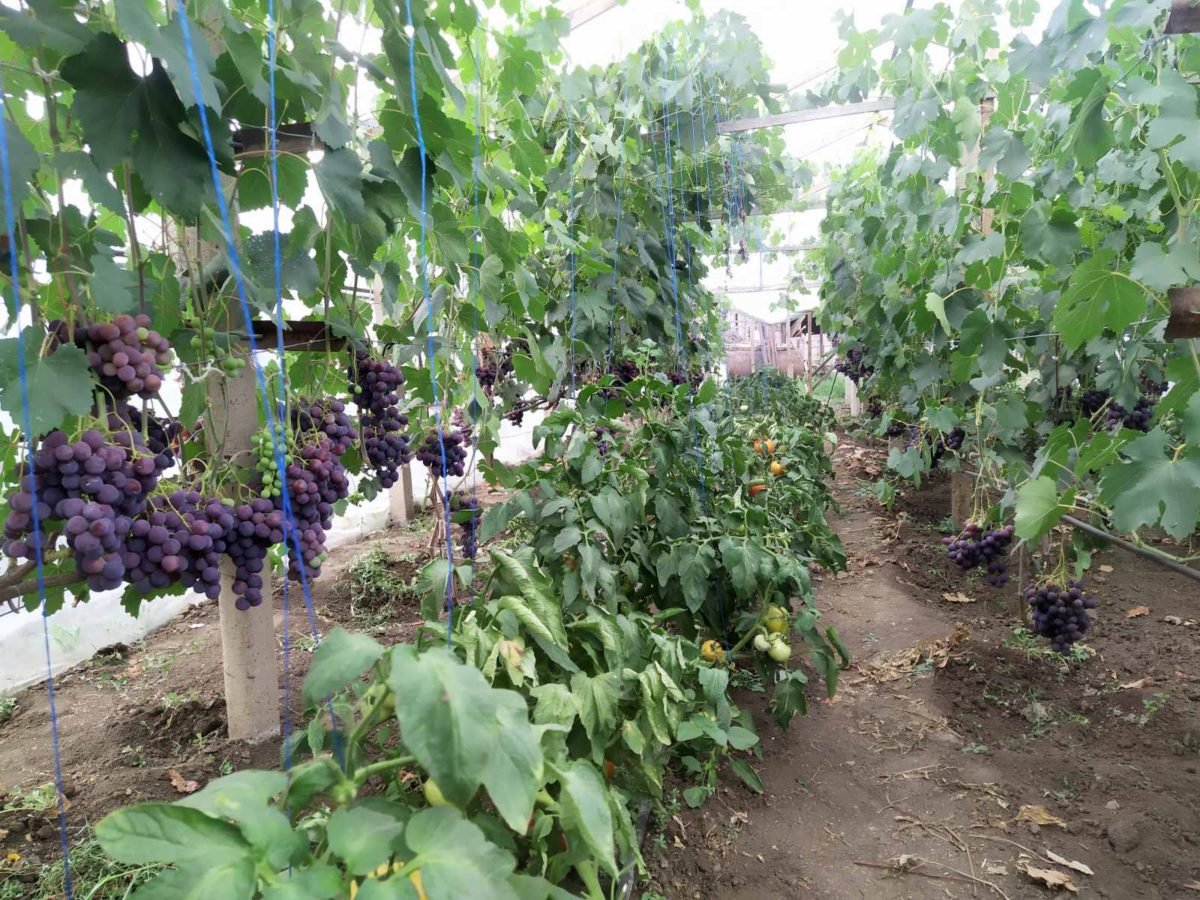
The greenhouse creates favorable conditions not only for grapes, but also for certain diseases and pests.
Common diseases:
- Downy mildew (false powdery mildew): Oily spots on leaves, with a white coating on the underside.
- Control measures: Preventive treatment with copper-containing preparations (Bordeaux mixture, Oxychom, Ridomil Gold). Good ventilation.
- Powdery mildew (Oidium): Ash-gray coating on leaves, shoots, and berries. Smell of rotten fish.
- Control measures: Treatment with sulfur preparations (colloidal sulfur, Thiovit Jet) or systemic fungicides (Topaz, Skor).
- Gray rot: Affects berries, especially in damp weather or in dense plantings.
- Control measures: Thinning of bunches and leaves, good ventilation. Treatment with fungicides (Switch, Horus).
- Anthracnose: Brown spots with a dark border on leaves, shoots, berries.
- Control measures: Treatment with copper-containing preparations.
Common pests:
- Spider mites: A very common in greenhouses. They produce fine webbing on the undersides of leaves, causing them to turn yellow.
- Control measures: Increase air humidity. Treatment with acaricides (Fitoverm, Actellic, Sanmite).
- Aphids: Attack young shoots and leaves.
- Control measures: Spraying with soap solution, insecticides.
- Grape itch mite (phytoptus): Forms swellings (galls) on the leaves.
- Control measures: Treatment with acaricides or sulfur preparations in spring.
- Greenhouse whitefly: If there are other crops, it can spread.
- Control measures: Sticky traps, insecticides.
Preventive measures:
- Use of healthy planting material.
- Compliance with agricultural technology (correct pruning, watering, fertilizing).
- Ensuring good ventilation.
- Timely removal and destruction of affected plant parts and plant debris.
- Preventive treatments with fungicides and insecticides (if necessary, strictly observing the waiting periods).
Harvesting and storage
- Harvesting time: Dependent on the variety and greenhouse conditions. It's determined by the berries' appearance (color, size), taste (sugar accumulation), and peduncle condition (when the berries are beginning to harden).
- Harvesting technique: The bunches are cut with sharp pruning shears or scissors in dry weather, taking care not to damage the berries or rub off the waxy coating (pruine).
- Storage:
- Table grape varieties can be stored from several weeks to several months under certain conditions (temperature 0…+2°C, humidity 90-95%).
- The bunches can be hung on a wire, placed in boxes in a single layer, sprinkled with sawdust, or stored in special conditions.
Your greenhouse vine is a source of pride and pleasure.
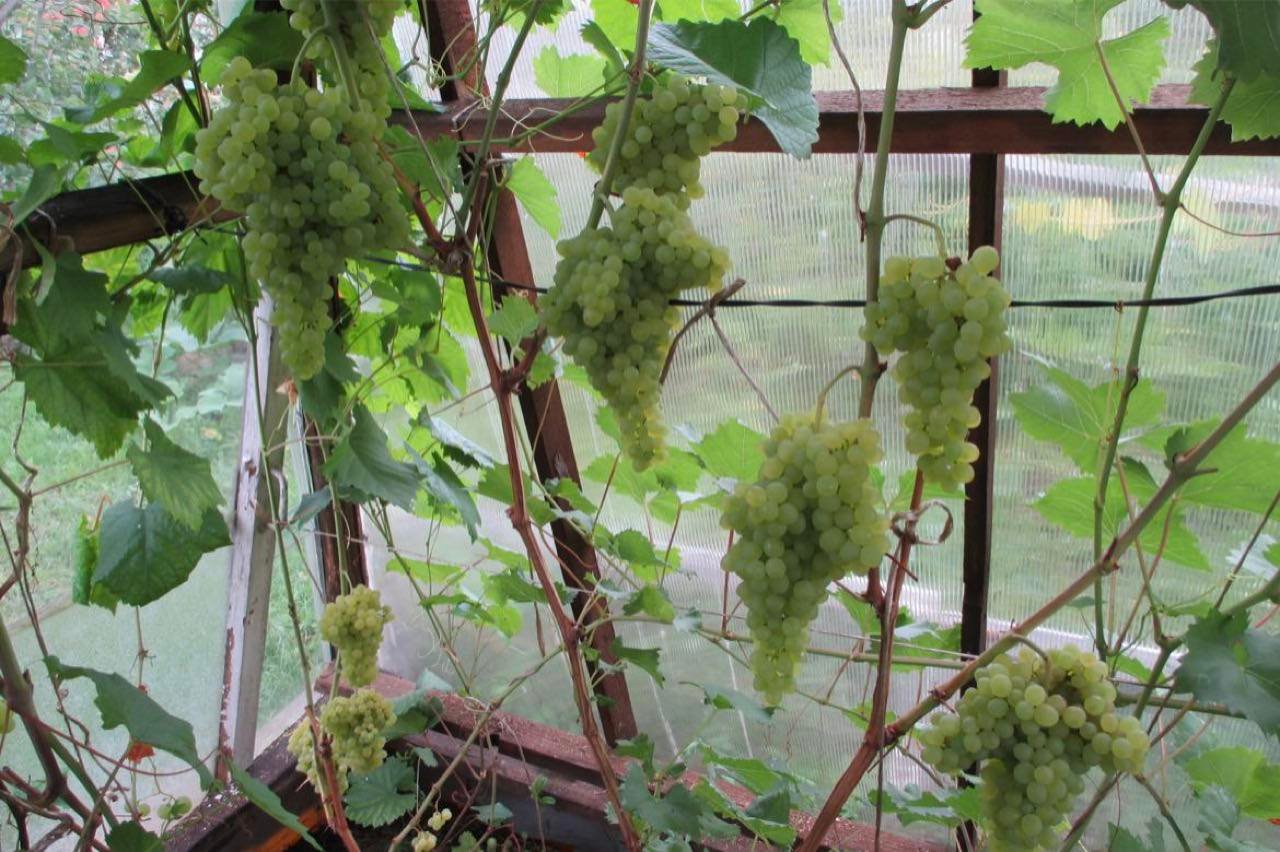
Growing grapes in a greenhouse – this is undoubtedly a labor of love, requiring knowledge, attention, and patience. However, as we've seen, the rewards are worth it. Creating a controlled microclimate allows you not only to outwit nature's whims and achieve a bountiful harvest where it seemed impossible, but also to achieve the highest quality of sunny berries. We've covered every step of this exciting journey in detail: from choosing the perfect variety for your greenhouse conditions and laying the foundation for your future vineyard—proper soil preparation and planting—to the complex yet captivating art of vine training and daily care, including balanced watering, timely fertilizing, and maintaining an optimal balance of heat, light, and moisture.
A conscious approach to disease and pest prevention, as well as proper harvesting and storage, will allow you to fully enjoy the fruits of your labor. For a winegrower, a greenhouse becomes more than just a glass or polycarbonate structure; it becomes a true creative laboratory where you can experiment, hone your skills, and achieve impressive results.
Let every bunch of grapes you grow in your greenhouse become not only a delicacy for your family, but also a source of well-deserved pride, a symbol of your perseverance and love for this noble plant. After all, there's nothing more delicious than sun-warmed grapes, grown with love and skill!





